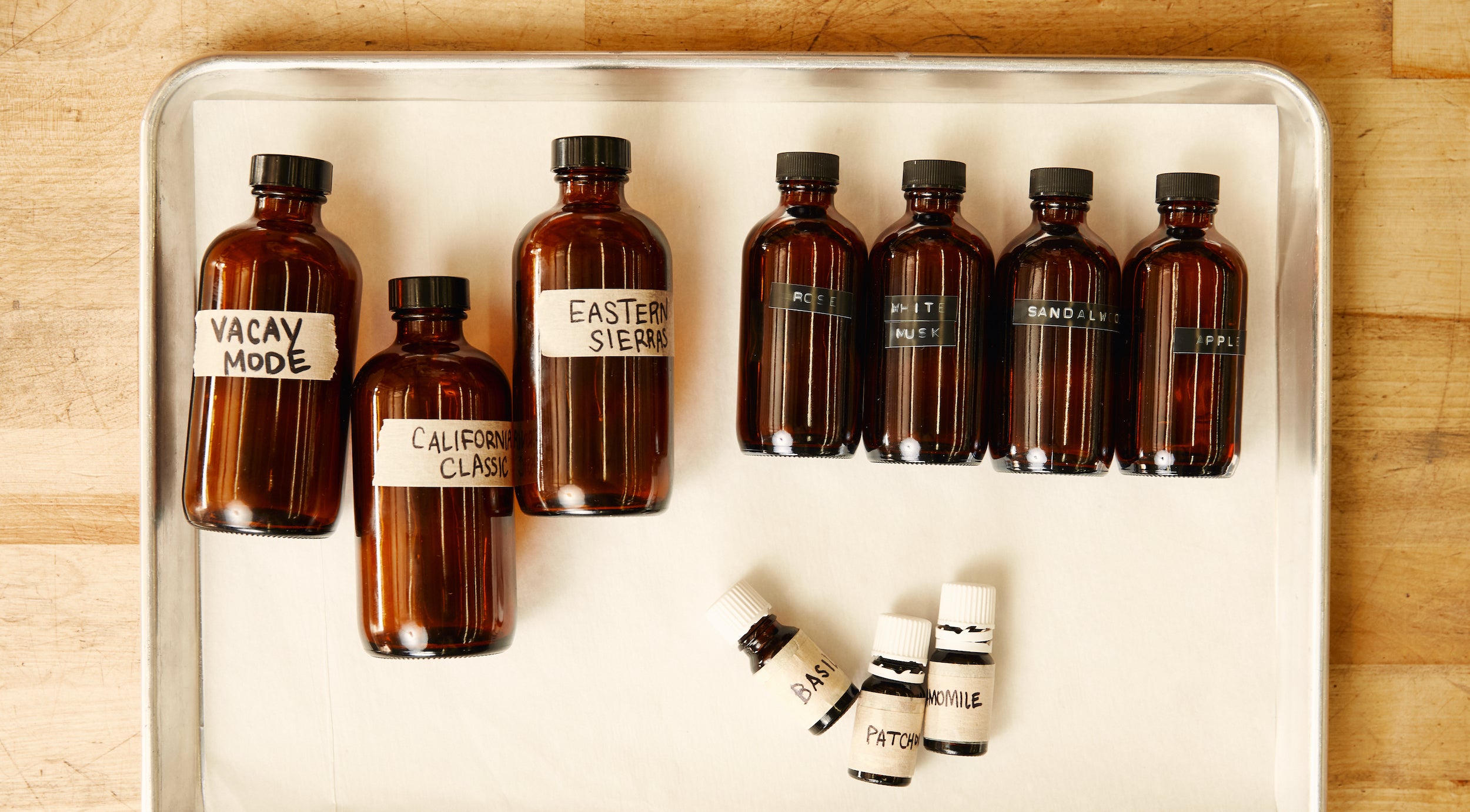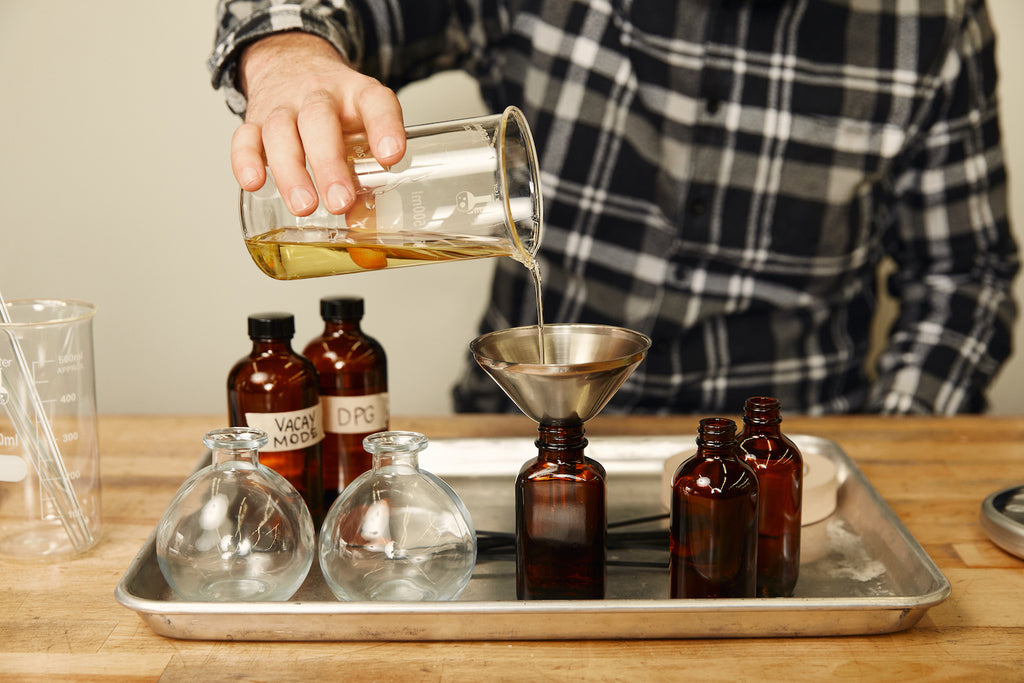
Take Notes: Fragrance 101
by Kristen Pumphrey
Since antiquity, civilizations have used perfumes to fragrance their body as well as space. In Ancient Egypt, they used incense in rituals to invoke the gods, and it’s said that Cleopatra anointed herself in jasmine oil (Shakespeare wrote that the sails of her ship were “so perfumed that the winds were lovesick with them”). Rosemary has been used as far back as Ancient Greece for memory and cognition (is that how they wrote all that philosophy?)
Still today, fragrance is used for both function, ritual, and beauty. My personal belief is that fragrance is an essential part of your home design — that finishing touch that personalizes your space.
So, what the hell is fragrance anyway?
Simply put, fragrance is just molecules. It’s quite literally a science, but in practice, it’s also an art. Everyone brings their own unique biochemistry when smelling fragrance, which is why fragrance is a different experience for each individual.
Fragrance oils are mixtures of fragrance molecules, typically in some sort of diluted base like alcohol. There are two main types of fragrance oils: natural and synthetic.

Not all naturals are essential oils, although those are the most widely known. Naturals possess incredible depth and character, but can be inconsistent because they are a natural crop that changes year to year. Some naturals are very resource intensive — for example, it takes 8,000 roses to make just 5mL of essential oil. Other fragrances are not feasible to produce naturally, as the raw ingredient may be endangered, like sandalwood.
Types of Naturals:
Synthetic fragrance compounds are made in a lab. In synthetics, there are single molecules and accords. Single molecules are single note compounds like coumarin or vanillin. Accords mimic natural fragrances by arranging single molecules together in robust harmony. So, for example, a coumarin molecule would be added to create a vanilla accord.
Synthetic fragrances are cost effective and consistent, and you can also potentially control allergic reactions by eliminating molecules that will trigger allergies.
Synthetics get a bad reputation because of the assumption that natural is best and synthetic is not safe. The fragrances that we use adhere to standards for safety set by IFRA and the EU, and we have multiple team members dedicated to monitoring these guidelines to ensure we are always producing safe products.
If you’re feeling freaked out by chemicals, remind yourself — toxicity is not a matter of ingredient, but dose. Anything, including water, can be toxic in too high of a dose.
We take a balanced approach, using both synthetics and naturals to fragrance our products. What it boils down to is performance, sustainability, cost, and artistic direction.
Many make the assumption that if you want a “safe” fragrance, you should use something natural. As Luca Turin and Tania Sanchez said in their book, Perfumes A-Z Guide, (I highly recommend this book for amping up your fragrance terminology game), “... even assuming you find fragrances that are 100 percent natural, there is no guarantee that they will be healthier for you (many natural compounds are toxic), non allergenic (the list of plant allergens is long), or even good for the environment (natural Mysore sandalwood is heavily endangered due to its use in fragrance).”
Fragrance not only makes your home smell better, but it can capture moods, memories, and feelings. It’s that little oomph that takes your home from “oh this is nice” to being safe, cozy, relaxed, vibrant — or whatever else feeling you want to imbue. You can feel confident using our products knowing that not only do they smell great, but there’s a team working behind the scenes to ensure that they’re safe.
If you liked this and would like to learn more about home fragrance and how to use it in your space, check out our book, At Home with Fragrance!
[ SHOP OUR BOOK ]

Still today, fragrance is used for both function, ritual, and beauty. My personal belief is that fragrance is an essential part of your home design — that finishing touch that personalizes your space.
So, what the hell is fragrance anyway?
Simply put, fragrance is just molecules. It’s quite literally a science, but in practice, it’s also an art. Everyone brings their own unique biochemistry when smelling fragrance, which is why fragrance is a different experience for each individual.
Fragrance oils are mixtures of fragrance molecules, typically in some sort of diluted base like alcohol. There are two main types of fragrance oils: natural and synthetic.

Naturals
Types of Naturals:
- Essential oils: These are made using one of three processes: Cold press, steam distillation, and CO2 extraction.
- Absolutes: These naturals are extracted using fat or a chemical like hexane. Typically the natural material is put into the fat/chemical and then it is washed away to get the fragrance material.
- Isolates: Not made using one of the essential oil extraction methods, but still a natural (ex. to extract the fragrance molecule, linalool, from a natural source, they would do so through a chemical process that isolates it from rosewood.)
Synthetics
Synthetic fragrances are cost effective and consistent, and you can also potentially control allergic reactions by eliminating molecules that will trigger allergies.
Synthetics get a bad reputation because of the assumption that natural is best and synthetic is not safe. The fragrances that we use adhere to standards for safety set by IFRA and the EU, and we have multiple team members dedicated to monitoring these guidelines to ensure we are always producing safe products.
If you’re feeling freaked out by chemicals, remind yourself — toxicity is not a matter of ingredient, but dose. Anything, including water, can be toxic in too high of a dose.
Our Approach
- Performance wise, the ingredients used in your fragrance oils can significantly impact the performance of the product — from the way it burns to its scent throw. Working with naturals and synthetics allows us to tweak this performance in partnership with the fragrance houses who produce our scents in large batches.
- From a sustainability standpoint, certain naturals are in such high demand (like the rich and sumptuous ingredient oud, which is from the heartwood of the agar tree, agarwood) that they are actually becoming endangered.
- The products we produce are also considered vegan. Some people wonder — what’s not vegan about a fragrance? Certain molecules, particularly in the animalic family, were originally sourced from animals. Musk was sourced from the musk deer, castoreum from beaver glands, and civet from the civet cat.
- Naturals can be expensive and would significantly increase the cost for our consumers — especially if we went the essential oil route. Using a blend of both allows us to control costs for both our business and our customers.
- Lastly, and very important, is the artistic direction. I compare using only natural fragrances to a painter who uses pigments from only natural sources, like avocado skins or turmeric. Super cool, but limits your palette. Using only synthetic molecules would create a scent that lacks depth. Using both naturals and synthetics allows us to create incredible, true to life fragrances that perform well and can also be modified to meet regulatory needs.
Many make the assumption that if you want a “safe” fragrance, you should use something natural. As Luca Turin and Tania Sanchez said in their book, Perfumes A-Z Guide, (I highly recommend this book for amping up your fragrance terminology game), “... even assuming you find fragrances that are 100 percent natural, there is no guarantee that they will be healthier for you (many natural compounds are toxic), non allergenic (the list of plant allergens is long), or even good for the environment (natural Mysore sandalwood is heavily endangered due to its use in fragrance).”
Fragrance not only makes your home smell better, but it can capture moods, memories, and feelings. It’s that little oomph that takes your home from “oh this is nice” to being safe, cozy, relaxed, vibrant — or whatever else feeling you want to imbue. You can feel confident using our products knowing that not only do they smell great, but there’s a team working behind the scenes to ensure that they’re safe.
If you liked this and would like to learn more about home fragrance and how to use it in your space, check out our book, At Home with Fragrance!




1 comment
A reader-friendly article that highlights the significance of fragrance concentration, enriching our sensory experience.
Thanks for sharing this article.